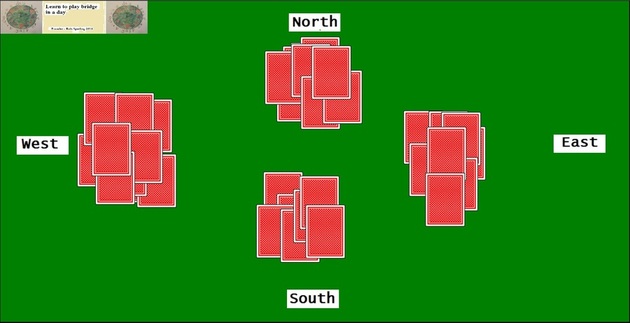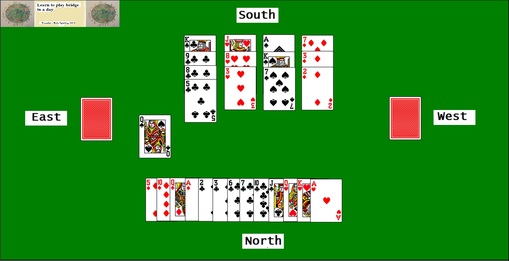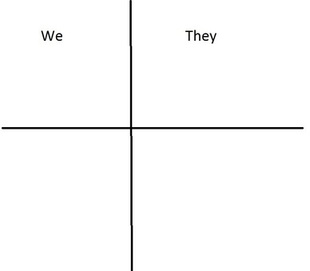Lesson 3 - Bridge basics - 45 mins
The HelpcardPrint out this helpcard now and keep it close to hand. This is really important
You won't understand it yet but it will prove very useful to you when you play bridge. If you play bridge in a club, you are encouraged to have your helpcard with you. You should refer to your helpcard for every bid, and every play, until you feel confident enough to do without. It will also help you with the quizzes. If you don't have access to a printer then you can access the helpcard through the link above and then save it as a favourite or bookmark. The idea of the game
Your aim in bridge is to have fun. Second to this is having more fun. There are few better ways of having fun than beating your opponents. Bridge is played in pairs called partnerships. You score points in bridge and the partnership with the most points win. More on scoring later.
Where to play
With friends down the pub with a wager is the best option for me. While you're learning, it may be fun to play on-line or buy a computer game or app. Every bridge club welcomes new faces and you can play for as little as the price of a pint of beer or a small wine. If you don't have a partner, the club will help you find a suitable one.
The cards
Buy a couple of decent packs. Plastic coated cards will last you years and cost less than a Magnum ice cream in most corner shops. In bridge, all 52 playing cards are used. Any jokers will have to stay in the pack as they are not used in bridge.

The players
Bridge is normally a game for 4 players.
You always have a partner in bridge. It is a team game and requires team work to enjoy the game. Traditionally in bridge the four players are known as North, East, South and West. North partners South and East partners West. Partnerships sit opposite each other. Partnerships are really important and you will find ways to help you choose the right partner in lesson 4.

The dealer
The host, or anyone else who is brave enough, places the cards face down and spreads them across the table. A player from each partnership selects a card and the holder of the highest card becomes the first dealer. The ace is the highest card then the king, queen, jack, 10, 9, 8, 7, 6, 5, 4, 3 and 2. In the event that both players draw the same card, try again.
The first dealer takes up all the cards and is responsible for passing the cards out, one by one, to each player.
The shuffle
The cards are shuffled well by the dealer who then offers either opponent the opportunity to cut the pack. This means that they separate the pack into two and put the lower half on the top. This is to avoid any card sharkery. Cheating is not allowed in bridge. There is a great card game called ' cheat' if that is your way.
The deal
The dealer deals a card face down to the opponent on the left and then one at a time to each player in a clockwise fashion until all 52 cards have been dealt. Each player will now have 13 cards laid before them, face down, as in the picture below.

Wait until the dealer has completed the deal before picking any of your cards up. As long as you deal all the cards in a reasonable time and the right way up, enjoy it.
Once each hand has been played, the next player on the left takes the turn to deal.
Suits
There are four suits in bridge. Each is ranked. Spades ranks the strongest and clubs the weakest:
- spades (♠)
- hearts (♥)
- diamonds (♦)
- clubs (♣)
It's not quite a suit but you can play no trumps in bridge and no trumps outranks them all. When you play in no trumps there is no trump suit.
The reason why the suits are ranked is to help with bidding. You will learn more shortly.
Sort your hand into suits (Helpcard - 1)
Pick up your cards and arrange them in a hand as in the picture below.

Bidding (Helpcard - 3-5)
Bridge evolved from a game called 'auction'. Half the fun of bridge is the auction. One big difference between the two is that in a car auction you can sit there and stay quiet. In bridge, you have to speak. You either bid or pass.
In an auction for a car, house or pig, the bidder must bid a higher price to get the goods. That bidder 'contracts' with the auction house to buy the goods at a certain price. In bridge, the goods are better thought of as a contract.
When you 'bid', you are saying that your hand is strong enough to beat your opponents. In other words, that you have higher cards than your opponents.
Confused?
I'm sorry I'm trying to make this easy but don't worry if you can't take it all in now as the quizzes will really help.
In short, the partnership that bids highest make a contract to make, at least, what they bid.
The dealer is the first player to bid or pass. The turn then passes clockwise until there have been 3 consecutive passes. That signals the end of the auction and whatever is the last bid becomes the contract.
A bid of 1 spade says that you and your partner intend to make 7 tricks with spades as trumps (more about tricks and trumps shortly). A bid of 2 diamonds says that you intend to make 8 tricks with diamonds as trumps. And so it continues.
Any bid made, as in any auction, must be higher than the last. For instance if the player to your right bids 2 hearts, you may not bid below 2 hearts e.g. 1 club or 2 diamonds or even 2 hearts. Your first allowable bid is 2 spades. The helpcard will help but try to remember that in bridge the highest ranked suit is no trumps, then spades, then hearts, then diamonds, then clubs.
If all 4 players pass then no points are scored and the cards are reshuffled and dealt again by the player on the left of the last dealer.
Declarer
The partnership that made the highest bid become the declarers. Their bid then becomes a contract e.g. 4 spades. The person in the partnership who first bid the contract suit, spades in this case, becomes the declarer and plays the hand.
| West |
North |
East |
South |
| 1♠ |
Pass |
2♦ |
3♣ |
| 3♠ |
5♣ |
5♠ |
6♣ |
| Pass |
Pass |
6♠ |
Pass |
| Pass |
Pass |
|
|
In the bidding example above, the final contract is 6 spades. West first bid spades and becomes the declarer.
Trumps
When you play a card, every other player has to follow suit. If they can't follow suit, they either discard any card of their choice or they use a trump card. A trump card outranks any other card and will win the trick unless another player plays a higher ranked trump card.
The suit chosen as trumps is the one that wins the auction. In the bidding example above, spades was the last suit bid and so the trumps will be spades.
Dummy
After winning the contract, declarer's partner becomes the dummy and will take no further part in the hand other than to lay out their cards after the first lead is made.

Tricks
The player to the left of the declarer is the first to play. They play a card of their choice face up on the middle of the table. In the example above, they play the queen of spades. It is then up to declarer's partner to lay out the dummy as above. Dummy here is South. In the real game only South's hand would be visible for all. Any trumps are placed on the left. The declarer now plays two hands. Their own and dummy's.
The declarer must choose and play a card from dummy of the suit led if possible. This is called following suit. Then it is the turn of the opponent to the right to play and then the declarer plays the last card from their own hand. Whoever has the highest card wins the trick. All four cards are collected together and laid face down beside a nominated member of the partnership that played the highest card, or trump. This now counts as one trick.
There are 13 tricks in each hand of bridge. At the end of the hand, the tricks are counted up to see if the contract is made. The hand is then scored.
Play (Helpcard - 6)
Bridge is a game of an octillion of possibilities and you will have to think on your feet many times. The play is a very enjoyable part of bridge and in lesson 13 you will find some guidelines which will help you play well.
Scoring (Helpcard - 9)
Scoring is not easy to remember but fortunately, if you learn the basics you can print off the helpcard so that you don't need to remember anything else. More on scoring in lesson 15.

Finally
Congratulations. If you have got this far and have a fair idea of what has gone before, you will soon love bridge.
If you haven't got a clue what I've been talking about or want to ask any questions just e-mail Rols
Now take the bridge basics quiz.
Bridge basics - quiz

Home
Copyright © August 2013 Rols Sperling
All rights reserved. Please e-mail Rols if you want to use any of the materials on this site.
|